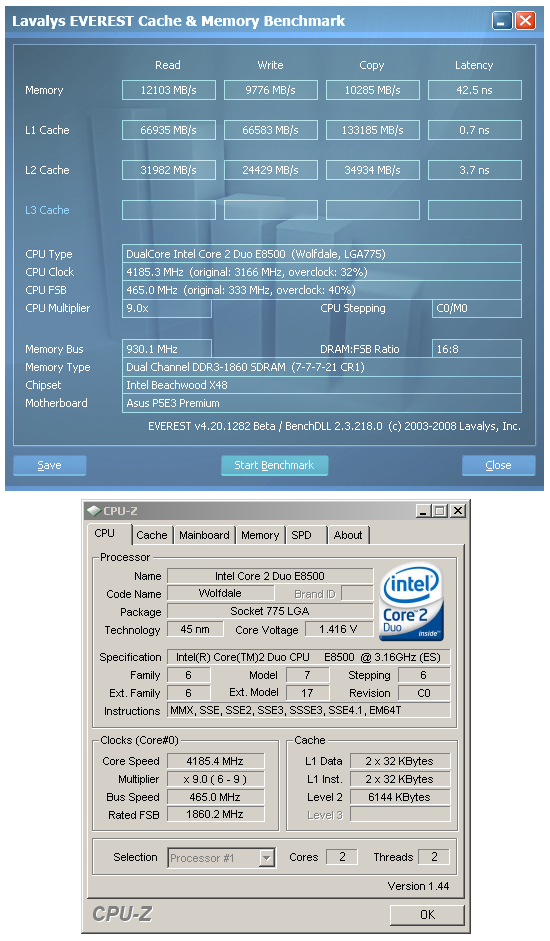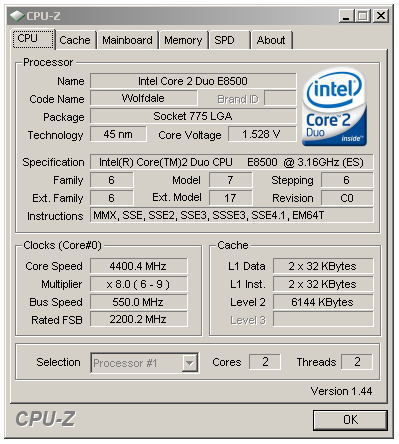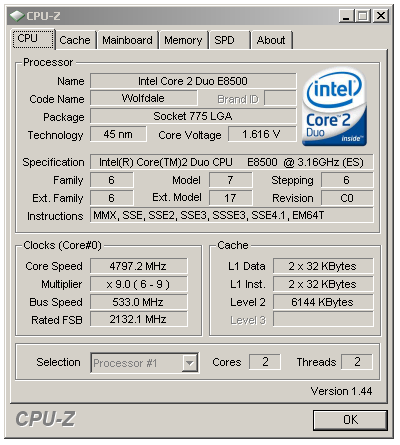ASUS P5E3 Premium: One to Rule them All…
by Kris Boughton on February 20, 2008 12:15 AM EST- Posted in
- Motherboards
Memory Overclocking

These are some of the highest memory read scores and lowest latencies we have ever seen on an Intel chipset. This is exactly where DDR3 starts to show its real power.
It's hard to argue with the performance potential this system brings at these settings, something that current X38 users might find impossible when aiming for total stability. Perhaps the most impressive point in this accomplishment is that our MCH required only 1.35V in order to run hour after hour of Prime95 or other stress tests without error. There are those that may believe this is not much to speak of, but the combination of high CPU speed and low tRD is brutal on the MCH - something we plan to explore soon in great detail. In fact, this is exactly where the X48 chipset begins to shine - in some of the situations where the X38 would either fall flat on its face or require voltages well in excess of those we feel comfortable using on a daily basis.
CPU Overclocking
 While 4.5GHz on a 45nm dual-core might not seem that impressive, we were able to get this system stable at these settings with water-cooling alone. Click to view Prime95 in action. |
The typical 45nm dual-core usually tops out around 4.0 to 4.2GHz on water-cooling or air-cooling alone, at least when it comes to achieving a truly stable overclock. Getting our E8500 sample to 4.5GHz stable took a little patience and a lot more Vcore than we feel comfortable using. Nevertheless, we ran Prime95 here for days while keeping temperatures under control (about 55C maximum in a 20C room). Most people who overclock knows just how difficult this can be.
Again, we must give a lot of credit in the success of this overclock to the power of the X48 chipset. This is also a great demonstration of ASUS' ability to design a very capable VRM circuit. Current draw under full-load at these speeds is impressive to say the least. Any other less capable power delivery design probably would have gone down in a blaze of glory (we had several in the labs that did just that trying to keep up with this board). This all just goes to show that although not specifically built for gaming per say, the P5E3 Premium is more than capable of keeping up with ASUS' very own R.O.G. line of motherboards. (Ed: Now if we could just do something about the lack of SLI….)
FSB Wars: Return of the Stupid-High Screenshot

For the general bemusement of the FSB crowd, we decided to include a screenshot of our board's maximum FSB using stock cooling and respectable voltages. While higher FSB speeds may be achievable, we can hardly imaging using them at this point. Intel's 45nm dual-core speed binning process promises to play a much more active role in the release of all future CPUs. Those that think they are going to pay for a budget chip and then turn around and overclock it to the same speeds as top-end Extreme CPUs are in for a rude awakening based on our early retail results. Keep in mind that our absolute maximum stable overclock was barely made using a multiplier less than the E8500's stock 9.5x value and you should begin to see one reason why these uber-high FSB speeds are just plain unneeded.

No quick look at overclocking performance would be complete without the obligatory maximum CPU frequency suicide-run screenshot. Just what the maximum achievable frequency was had more to do with our nerves than anything else. Given the voltage, our E8500 was more than happy to continue scaling ever higher. At some point though we said enough is enough and called it quits - that point came when we saw that we were subjecting our poor 45nm CPU to over 1.6V, simply a voltage that will require your credit card to be handy for another CPU in short time. Quite simply, we believe any voltage over 1.45V is asking for danger on the 45nm processors and conversations with Intel seem to back-up our beliefs right now. Our only solace is that we were quick when it came to gathering these results.










32 Comments
View All Comments
ArthurCanada - Thursday, October 2, 2008 - link
Indeed folks. This is the most advanced and powerful board I have ever installed in a computer. I am running Vista Ultimate 64 bit and pushing my E8500 to 4 Ghz per core, much like in the testing. I can't begin to tell you how fast this motherboard with the E8500 is.For overclockers ... this is the board they have been waiting for. Period!
Arthur
Canada
drnick79 - Tuesday, April 1, 2008 - link
HelloI purchased this board with 2x1GB sticks of OCZ DDR3 1800 memory to use with my e8400 CPU (which I can get stable to at least 4050mhz on other mobos). What RAM did you use for this testing? I can't even come close to running stable at the settings you have listed, nor can I score any higher than about 11,500MB/sec read and 46ns with everest benchmark, and the settings I used to achieve those values are very unstable. And 1N memory settings??? This board won't even post if I set the memory to 1N running the memory over 1333mhz.
Just wondering if you could share the RAM brand you used along with your motherboard and RAM voltage settings to achieve such a feat.
Thanks,
Nick
HotBBQ - Monday, February 25, 2008 - link
"With an estimated retail price of around $299, there is a lot of value in the purchase of the P5E3 Premium for those looking at a high-end motherboard to use in the coming years."Where did the $299 come from? The X38 version of this board comes it at $340.
fabz - Saturday, February 23, 2008 - link
HiGreat review! I have been reading alot here att anandtech and generally all over the web preparing my first ever pc-build. Intel seem to be the way to go.
But,
have a look at the link posted below:
http://www.hardware.info/nl-NL/productdb/bGRkapiTm...">http://www.hardware.info/nl-NL/productdb/bGRkapiTm...
The DDR3 power circuit is different to the one here att anandtech. Still it claims to be the same board. At least so it seems to me. A couple of other sites have the same pics with different power circuits.
Are there different versions of the P5E3 PREMIUM/WIFI-AP@N in circulation? If so, how do i tell them apart before buying?
/Fabricio@cold, dark winter-sweden.
Aivas47a - Friday, February 22, 2008 - link
The one request I've had for Asus lately is to provide greater flexibility for fine-tuning of GTL reference voltages, as this is key especially for quad core overclocking. I'm delighted that Asus has apparently listened and responded.KainAT - Thursday, February 21, 2008 - link
Hi Kris. Very nice view for the mobo.As you have been practicing and analizing a lot on how doe sthe GTL reference voltage works, which settings for CPU and NB on GTL did you used for 550 FSB?
Also, which voltage should you consider to be the max for 24/7 situations? Around 1.4v?
If we had to do an analogy, between conroe and Wolfdale, when Conroe max voltage for 24/7 was around 1.5-1.6volts, on that time, being 1.3v the stock aprox. Now, with Wolfdale, 1.125v is about the common VID, so, which would be the voltage limit for 24/7?
Thanks on advise.
Kain
PolymerTim - Wednesday, February 20, 2008 - link
Maybe I missed the system specs. I can see the proc in the CPU-z shots, but I'm really curious what RAM you used for this test. Even though I know the MB is critical for getting this kind of performance out of the RAM, not mentioning which one you use seems to imply that you can get these results with any decent DDR3 RAM. Is that so?Thanks very much for the article. I very much appreciate reading a well crafted piece like this with lots of insight.
Xvys - Wednesday, February 20, 2008 - link
While this looks like a nice m/b, I am not as astounded by the memory performance as the writer of the article. On my Asus P5K-D, I acheived 44.5ns latency and memory read of 11,250...with only 2/3rds of the memory bus of the tested board. I am sure I could improve on that figure a fair bit if I was optimized the speed and timings for that purpose.AllanLim - Wednesday, February 20, 2008 - link
Yes, the X48 looks impressive as it should, but let's not forget this is NOT a retail sample. I just think it's misleading and premature to claim "To rule them all" when we haven't even looked at other X48 mobos.kjboughton - Wednesday, February 20, 2008 - link
Hi, to date we have reviewed the following Intel X48 boards: Gigabyte GA-X48T-DQ6, ASUS R.O.G. Rampage Formula, MSI X48 Platinum and ASUS P5E3 Premium (with the possibility of more to come). Thank you.